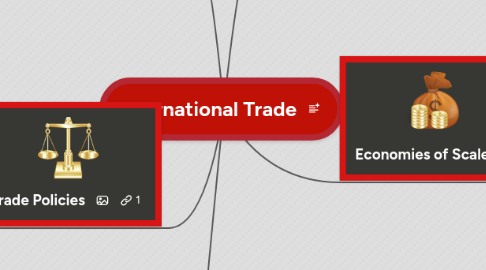
1. Policies
1.1. Political Economy of Trade Policy
1.1.1. For Free Trade
1.1.1.1. Allocation of Resources is Efficient
1.1.1.2. Economies of Scale (EoS)
1.1.1.3. Competition & Opportunities for Innovation
1.1.1.4. Rent Seeking
1.1.2. Against Free Trade
1.1.2.1. Terms of Trade (ToT) Gain
1.1.2.2. Optimum Tariff
1.1.2.3. Domestic Market Failure May Exist
1.1.3. Political Model of Trade Policy
1.1.3.1. Median Voter Theorem
1.1.3.2. A model that combines aspects of collective action and the median voter theorem
1.1.3.3. Collective Action
1.1.4. World Trade Organization (WTO)
1.1.4.1. Reducing Tariff Rates
1.1.4.2. BInding Tariff Rates
1.1.4.3. Eliminating Non-Tariff Barriers
1.2. Trade Policy in Developing Countries
1.2.1. Import-substituting industrialization
1.2.1.1. Infant Industry Argument
1.2.1.1.1. Gov. Support of Industry Growth
1.2.1.1.2. High Tariff Increases Profits in New Industry
1.2.2. Trade liberalization
1.2.2.1. Mixed Evidence of Success
1.2.3. Trade and growth
1.2.3.1. High Saving & Investment Rate = Rapid Economic Growth
2. Trade Policies
2.1. Tariffs in a Single Industry
2.1.1. Costs & Benefits of Tariffs
2.1.2. Protectionism
2.1.3. Increase price for importers
2.1.3.1. Consumer surplus decrease
2.1.3.2. Producer surplus increase
2.1.4. Government gain tariff revenue
2.2. Export Subsidies
2.2.1. Paid by Gov.
2.2.2. Encourage Exports
2.3. Import Quotas
2.3.1. Quota Rents
2.3.2. Voluntary Export Restraint
2.3.3. Local Content Requirement
2.4. Other Policies
2.4.1. Bureaucratic Regulations
2.4.2. Gov. Procurement
2.4.3. Export Credit Subsidies
3. Models
3.1. Models
3.1.1. Ricadian Model
3.1.1.1. 1 Factor - Labor
3.1.1.2. Comparative Advantage
3.1.1.3. Opportunity Cost
3.1.2. Specific Factors
3.1.2.1. 3 Factors - Labor, Capital & Land
3.1.2.2. Perfect Competition
3.1.3. HO Model
3.1.3.1. 2 Factors - Labor & Capital
3.1.3.2. Changing Mix of Inputs
3.1.4. Standard Trade
3.1.4.1. Relative Supply & Demand
3.1.4.2. Terms of Trade & Welfare
3.1.4.3. Borrowing & Lending
3.1.4.4. Includes Previous 3 Models
4. Economies of Scale
4.1. External EoS
4.1.1. Cost/unit Output is Industry Size Dependent
4.1.1.1. Specialized Equipment of Services
4.1.1.2. Labor Pooling
4.1.1.3. Knowledge Spillover
4.1.2. Reduce Prices Everywhere
4.1.3. Trade has Ambiguous Effect on National Welfare
4.2. Internal EoS
4.2.1. Cost/unit Output is Firm Size Dependent
4.2.2. Monopolistic Competition & Trade
4.2.3. Dumping
4.2.3.1. Price Discrimination
4.2.3.2. Regarded as "Unfair" Trade by Most
4.2.4. Multinational Outsourcing
4.2.4.1. Foreign Direct Investment
4.2.4.1.1. Horizontal FDI
4.2.4.1.2. Vertical FDI
4.2.4.1.3. Tech Transfer (TT)
4.2.4.1.4. Vertical Integration
4.2.5. Intra-Industry Trade
5. Prof. Maquito
5.1. Quizes
5.2. Problem Solving
5.3. Debates
5.3.1. Team 2 is Awesome
